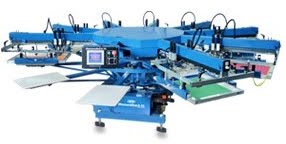Screen Printing 101
T-Shirt Art
Art begins with your imagination, either a drawing on paper or computer generated art. In any case the end result of the art will be computerized and separated by colors. For each color in your design we will need a screen. In short, the less colors in your design, the less your printing cost will be. The Fished Custom Printing Logo below is consist of three basic colors.

Underbase
Underbase is a layer of ink (generally white or other light color) that is printed as a "base" on a dark shirt for other colors to sit on. This gives the top colors more brilliance. An underbase is required and counted as one of your allotted colors when printing on colored (not white) shirts
TWO DIFFERENT TYPES OF COMPUTER GENERATED ART - VECTOR AND RASTER.
Vector Graphics
Rastor
Processing Screens
Screens are a frame with polyester fabric stretched onto them. The polyester fabric is a lot like the screen on your screen door, It has anywhere from 25 threads per inch, to 355 threads per inch (mesh count). The finer the detail in the design, The higher the screen mesh count will be.
We take a light sensitive emulsion (in a dark room) and apply a even coat to the screen mesh. We'll let that dry for about 6 hours.
After the light sensitive emulsion has dried, We will take the film positive and tape it to the back of the screen mesh. Then, we will place the screen on a device that emits light, Called an exposure unit, and expose the screen with light for a short period of time.
The dark areas (the image) on the film positive will prevent light from passing through and exposing the screen, The light will pass through clear areas of the film positive (where there is no design) and harden the emulsion.
We are left with a screen that has an image in it (as shown at top of page). The ink will pass through the open areas of the mesh. Next, we take the screen off the exposure unit and wash it with water. The water will not wash out the hardened emulsion. The water will wash out the soft areas that the light did not expose.
Setting Up the Screens for Printing
After making and exposing our screens, We need to prep the printing press for printing. We do this by setting each screen (color) into the press heads (a six color press has six printing heads). We will set them up by color, light colors first in sequence to the darkest color, usually black last.
We need to align each print color to the other to ensure correct registration throughout the printing process.
We then add ink colors to the screens and then squeegees to the screen print heads. The squeegees will move across the screen to push the ink through and onto the T-shirt
Printing
 After the screens are placed and aligned into the press we are ready to begin printing. A press has printing heads (one for each color) and pallets. The pallets are what we place the shirt on for printing. The screens will stay stationary during the printing process, while the pallets will rotate one at a time in a counter clockwise motion. Rising up to the screens after each index for printing. Then dropping down to move to the next station. Two people are needed for this operation, one for loading the shirt onto the pallet, and the other for taking the shirt off the pallet, Inspecting the shirt for imperfections and then setting it on the drying belt.
After the screens are placed and aligned into the press we are ready to begin printing. A press has printing heads (one for each color) and pallets. The pallets are what we place the shirt on for printing. The screens will stay stationary during the printing process, while the pallets will rotate one at a time in a counter clockwise motion. Rising up to the screens after each index for printing. Then dropping down to move to the next station. Two people are needed for this operation, one for loading the shirt onto the pallet, and the other for taking the shirt off the pallet, Inspecting the shirt for imperfections and then setting it on the drying belt.
Drying of the Shirt
 After the shirt is printed we place it on the dryers moving belt. The temperature inside the dryer is about 380 degrees. The shirt will only stay inside of the drying chamber for about 37 seconds. Enough to heat the shirt and ink to about 335 degrees which bonds the ink to the garment.
After the shirt is printed we place it on the dryers moving belt. The temperature inside the dryer is about 380 degrees. The shirt will only stay inside of the drying chamber for about 37 seconds. Enough to heat the shirt and ink to about 335 degrees which bonds the ink to the garment.
Another person is inspecting the shirts for quality as it makes it way to the end of the oven, then folds the garments in dozens.
Screen Printing ink consist of four major components. Pigment, (for the color). Oil (for the base). PVC's and Plasticizers. When heated to 330 degrees, The oil evaporates and the plasticizers turn the PVC into plastic. Yes, That print on your shirt is a thin coat of plastic bonded to the fabric of your shirt.
Packaging the Shirts
After the shirts are printed and dried, the folder at the end of the drying belt will inspect the shirt for quality and accuracy of the order.
